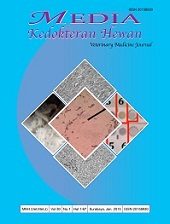Cytotoxicity of Kembang Bulan (Tithonia diversifolia ) Ethanolic Leaf Extract on Rabbit Limbal Mesenchymal Stem Cells
Downloads
Kembang Bulan (Tithonia diversifolia ) is known as an herbal plant that has many useful properties to cure disease, such as diabetes, malaria, and other infections. Instead of much usefulness, T. diversifolia has main biological properties that may induce toxicity in this plant known as sesquiterpene lactones. The aim of this study was to identify the cytotoxicity effect of T. diversifolia leaf extract on limbal mesenchymal stem cells of rabbits using the MTT assay. T. diversifolia leaf extract was divided into 4 concentrations (0.5%, 0.25%, 0.125%, and 0.0625%) and given to limbal mesenchymal stem cells of rabbits in 96-well microplates, which would be incubated for 24 hours. The cytotoxicity result was obtained using the MTT assay method. Every well would be observed to see the cell life level of each concentration. The optical density absorbance was calculated using a microplate reader. T. diversifolia leaf extract with a concentration of 0.0625% has the biggest viability with a level of existence of limbal mesenchymal stem cells of 50%, and the other T. diversifolia leaf extract concentrations of 0.5%, 0.25%, and 0.125% have less than 50% level of existence of limbal mesenchymal stem cells.
Abud, A.P.R., J. Zych, T.L Reus, C. Kuligovski, E. de Moraes, B. Dallagiovanna, and A.M. de Aguiar. 2015. The use of human adipose-derived stem cells based cytotoxicity assay for acute toxicity test. Regulatro. Toxicol. Pharmacol; 73(3): 992-998.
Ajao, A.A. and A.N. Moteetee. 2017. Tithonia diversifolia (Hemsl) A. Gray. (Asteraceae: Heliantheae), an invasive plant of significant ethnopharmacological importance: A review. South African J. Botany; 113: 396-403.
Ammar, L.A., B. Kurniawati, D. Anggorowati, A.P. Cahyaningsih, and A.D. Setyawan. 2021. Ethnobotanical study of the medicinal plant used by local communities in karst area of Pacitan District, East Java, Indonesia. Int. J. Trop. Drylands; 5(2): 84-93.
Amorim, M.H.R., R.M.G da Costa, C. Lopes, and M.M Bastos. 2013. Sesquiterpene lactones: adverse health effects and toxicity mechanisms. Crit. Rev. Toxicol; 43(7): 559-579.
Buranaamnuay, K. 2021. The MTT assay application to measure the viability of spermatozoa: A variety of the assay protocols. Open Vet. J; 11(2): 251-269.
Di Giacomo, C., L. Vanella, V. Sorrenti, R. Santangelo, I. Barbagallo, G. Calabrese, C. Genovese, S. Mastrojeni, S. Ragusa, and R. Acquaviva. 2015. Effects of Tithonia diversifolia (Hemsl.) A. Gray extract on adipocyte differentiation of human mesenchymal stem cells. PLoS One; 10(4): e0122320.
Djajanegara, I. and P. Wahyudi. 2009. Pemakaian sel HeLa dalam uji sitotoksisitas fraksi kloroform dan etanol ekstrak daun Annona squamosa. J. Ilmu Kefarmasian Indonesia; 7(1): 7-11.
Fischer, I., C. Milton, and H. Wallace. 2020. Toxicity testing is evolving! Toxicol. Res; 9(2): 67-80.
He, Y., Q. Zhu, M. Chen, Q. Huang, W. Wang, Q. Li, Y. Huang, and Y. Di. 2016. The changing 50% inhibitory concentration (IC50) of cisplatin: a pilot study on the artifacts of the MTT assay and the precise measurement of density-dependent chemoresistance in ovarian cancer. Oncotarget. 7(43): 70803-70821.
Li, W., J. Zhou, and Y. Xu. 2015. Study of the in vitro cytotoxicity testing of medical devices. Biomed. Rep; 3(5): 617-620.
Li, Y., W. Huang, S. Huang, J. Du, and C. Huang. 2012. Screening of anti-cancer agent using zebrafish: comparison with the MTT assay. Biochem. Biophys. Res. Comm; 422(1): 85-90.
Meizarini, A., E. Munadziroh, and P. Rachmadi. 2005. Sitotoksisitas bahan restorasi cyanoacrylate dengan variasi perbandingan powder dan liquid menggunakan MTT assay. J. Penelit. Med. Eksak; 6(1): 16-25.
Passoni, F.D., R.B. Oliveira, D.A. Chagas-Paula, L. Gobbo-Neto, and F.B. Da Costa. 2013. Repeated-dose toxicological studies of Tithonia diversifolia (Hemsl.) A. gray and identification of the toxic compounds. J. Ethnopharm; 147(2): 389-394.
Proboningrat, A., A.N.M. Ansori, A. Fadholly, N. Putri, M.K.J. Kusala, and A.B. Achmad. 2021. First Report on the Cytotoxicity of Pinus merkusii Bark Extract in WiDr, A Human Colon Carcinoma Cell Line. Res. J. Pharm. Tech; 14(3): 1685-1688.
Proboningrat, A, S. Jayanti, A. Fadholly, A.N.M. Ansori, N. Putri, M.K.J. Kusala, S.A. Sudjarwo, F.A. Rantam, and A.B. Achmad. 2021. The Cytotoxicity of Ethanolic Extract of Allium cepa L. on Hela Cell Lines. Res. J. Pharm. Tech; 14(9): 4969-4972.
Yuan, H., Q. Ma, L. Ye, and G. Piao. 2016. The Traditional Medicine and Modern Medicine from Natural Products. Mol; 21(5): 559.
Zhang, M., D. Aguilera, C. Das, H. Vasquez, P. Zage, V. Gopalakrishnan, and J. Wolff. 2007. Measuring cytotoxicity: a new perspective on LC50. Anticancer Res; 27(1A): 35-38.
Copyright (c) 2022 Hani Plumeriastuti, Vida Seanita Zahro, Nusdianto Triakoso, Fedik Abdul Rantam, Iwan Sahrial Hamid, Mustofa Helmi Effendi, Annise Proboningrat

This work is licensed under a Creative Commons Attribution-ShareAlike 4.0 International License.

Veterinary Medicine Journal by Unair is licensed under a Creative Commons Attribution-ShareAlike 4.0 International License.
1. The Journal allows the author to hold the copyright of the article without restrictions.
2. The Journal allows the author(s) to retain publishing rights without restrictions
3. The legal formal aspect of journal publication accessibility refers to Creative Commons Attribution Share-Alike (CC BY-SA).





11.jpg)







11.png)













